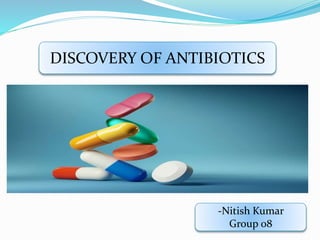
Discovery of antibiotics
- 1. DISCOVERY OF ANTIBIOTICS -Nitish Kumar Group 08
- 2. What are Antibiotics? Antibiotics, also known as antibacterials, are medications that destroy or slow down the growth of bacteria. They include a range of powerful drugs and are used to treat diseases caused by bacteria. Antibiotics cannot treat viral infections, such as cold, flu, and most coughs. This article will explain what antibiotics are, how they work, any potential side effects, and antibiotic resistance.
- 4. DISCOVERY OF ANTIBIOTICS This phenomenon has long been known; it may explain why the ancient Egyptians had the practice of applying a poultice of moldy bread to infected wounds. But it was not until 1928 that penicillin, the first true antibiotic, was discovered by Alexander Fleming, Professor of Bacteriology at St. Mary's Hospital in London.
- 5. HOW ANTIBIOTICS WERE FOUND ? The discovery of antibiotics revolutionized medicine in the 20th century. In 1900, infectious disease was a leading cause of death; in 2000, infectious diseases were responsible for only a small percentage of deaths in developed nations. Antibiotic consumption continues to rise among the low- and middle-income countries in recent years . Unfortunately, bacteria evolve rapidly, and resistance mechanisms have developed and spread for every antibiotic in clinical use soon after its introduction.
- 6. Some fear a return to the pre-antibiotic era because of the increasing prevalence of multi-drug resistant superbugs, the decreasing number of novel antibiotics to enter the market, and the departure of several pharmaceutical companies from the field of antibiotic research due to scientific, economic, and regulatory challenges. There is an urgent need for solutions that can drive rapid discoveries of novel antibiotics, especially those against multidrug-resistant tuberculosis and Gram-negative bacteria and community-acquired infections such as Salmonella spp, Campylobacter spp, N gonorrhoeae, and H pylori, as prioritized by World Health Organization . Here, I review past and current methods for the discovery and development of antibiotics and overcoming bacterial resistance.
- 8. S.A. Waksman defined an antibiotic as “a chemical substance, produced by micro-organisms, which can inhibit the growth of and even to destroy bacteria and other micro-organisms” Today, the term antibiotic is used more broadly to include any anti-microbial compound, whether of natural or synthetic origin Antibiotics inhibit bacterial growth by targeting essential cellular processes such as the synthesis of the bacterial cell wall, DNA/RNA, and proteins
- 9. In 1909, Paul Ehrlich discovered the very first antibiotics, synthetic arsenic-based drugs (Salvarsan), in a large screen of hundreds of organoarsenic compounds for use in the treatment of syphilis. The next antibacterials to be clinically used were the synthetic sulfonamides or the sulfa drugs.
- 10. Gerard Domagk discovered Prontosil, a red dye, while experimenting with azo dyes against bacterial infections in mice in 1935. The sulfonamide group was identified as the critical component in Prontosil, and this led to the synthesis of more than 5000 sulfa drugs between 1935 and 1945
- 11. Alexander Fleming discovered penicillin, the first natural product antibiotic, in 1928. He observed that Penicillium molds produced a diffusible extract that had antibacterial activity against staphylococci . Although Fleming performed several experiments in vitro, he did not test the extract against animal models, and penicillin was only used as a local antiseptic for many years
- 12. Florey and Chain elucidated the structure of penicillin, and in 1940 they showed that penicillin was active against streptococcal infection in mice. Following this discovery, penicillin started to be used systemically as an antibiotic, which then ushered in the golden age of antibiotics. In 1945, Fleming, Chain, and Florey were awarded the Nobel Prize in Physiology or Medicine for their discovery of penicillin.
